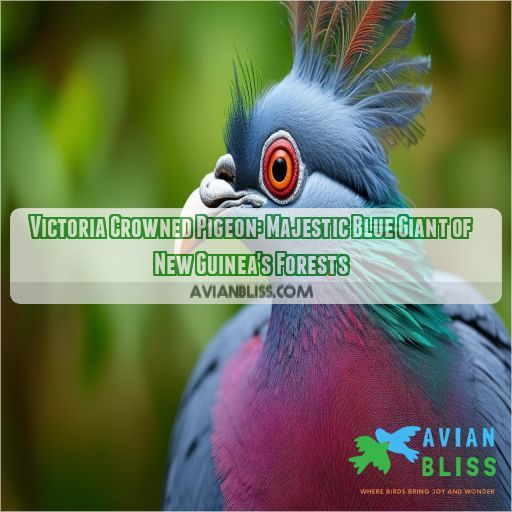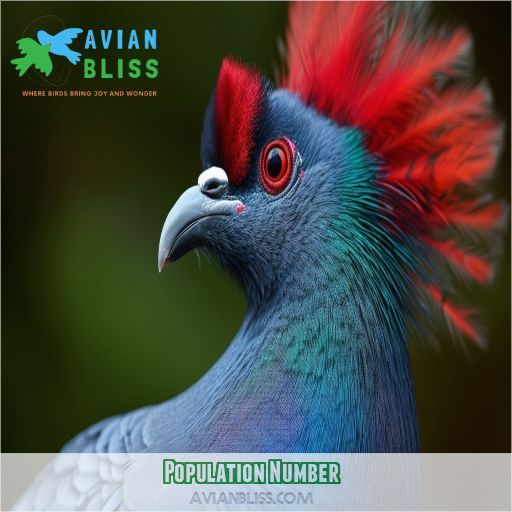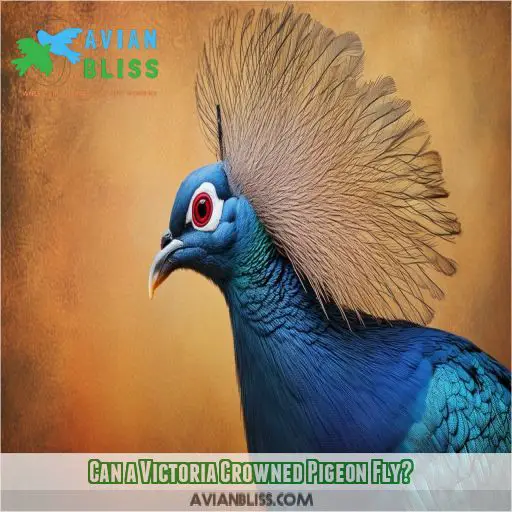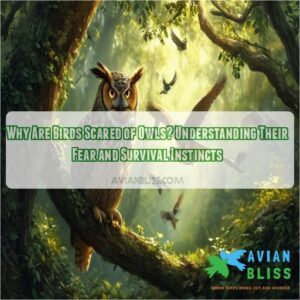This site is supported by our readers. We may earn a commission, at no cost to you, if you purchase through links.
 Discover the Victoria crowned pigeon, a majestic blue giant of New Guinea’s forests.
Discover the Victoria crowned pigeon, a majestic blue giant of New Guinea’s forests.
You’ll be captivated by this remarkable bird, the largest pigeon species in the world.
With its striking blue plumage and distinctive crown, it’s a sight to behold.
Learn about its unique characteristics, habitat, and the challenges it faces in the wild.
Uncover the power and beauty of this near-threatened species, and gain insights into its behavior, diet, and conservation status.
Master the knowledge of this extraordinary creature.
Table Of Contents
- Key Takeaways
- Victoria Crowned Pigeon Facts Overview
- Threats to the Victoria Crowned Pigeon
- Population Number
- Victoria Crowned Pigeon as a Pet
- Can a Victoria Crowned Pigeon Fly?
- Frequently Asked Questions (FAQs)
- Can you keep a Victoria crowned pigeon as a pet?
- Where can I find Victoria crowned pigeons?
- Are Victoria crowned pigeons rare?
- Can a Victoria crowned pigeon fly?
- How do Victoria crowned pigeons communicate with each other?
- What predators do Victoria crowned pigeons face in the wild?
- How do they adapt to changing environmental conditions?
- What role do they play in seed dispersal?
- How do their mating dances differ from other pigeon species?
- Conclusion
Key Takeaways
- Talk about a bird that’s dressed to impress! The Victoria crowned pigeon is the Beyoncé of the bird world, sporting a stunning blue ensemble topped with a fancy lace headpiece that would make any royal jealous.
- These gentle giants are more homebodies than high-flyers, preferring to strut their stuff on the forest floor. But don’t be fooled – when push comes to shove, they can reach heights of 3,000 feet faster than you can say "pigeon pie."
- Love is in the air for these lovebirds! Victoria crowned pigeons are the hopeless romantics of the animal kingdom, mating for life and wooing their partners with elaborate dance moves that would put John Travolta to shame.
- While they’re living large in zoos, these blue beauties are facing a tough time in the wild. Habitat loss and hunting have put them on the near-threatened list, proving that even royalty isn’t immune to life’s challenges.
Victoria Crowned Pigeon Facts Overview
You’ll find the Victoria crowned pigeon in the lowland and swamp forests of northern New Guinea and neighboring islands. This majestic bird, the largest wild pigeon species, boasts bluish-grey plumage with a maroon chest, red eyes, and a distinctive lacy crest, making it a sight to behold in its native habitat.
Habitat and Location
You’ll find the majestic Victoria crowned pigeon, the largest pigeon species, in the tropical moist forests of New Guinea.
These stunning birds call lowland and swamp forests home, thriving in the northern regions and neighboring islands.
As habitat loss threatens their existence, conservation efforts, including breeding programs and forest management, are essential.
Ecotourism offers hope, allowing you to witness these blue giants in their natural habitat while supporting their preservation.
Physical Characteristics
As you venture deeper into New Guinea’s forests, you’ll encounter the Victoria crowned pigeon’s striking appearance.
This unique ground-dwelling bird boasts an elaborate feather crest with blue lace-like crests and distinctive white tips.
Its maroon-tipped wings and maroon breast contrast beautifully with bluish-gray plumage.
At up to 75cm long and 3.5kg, it’s the largest wild pigeon, with red eyes that command attention.
Its monogamous mating habits add to its allure.
Behavior and Diet
You’ll find these magnificent birds traveling in pairs or small groups, foraging for fallen fruits, seeds, and insects. Their diet includes a variety of seeds, fruits, and vegetables. Victoria Crowned Pigeons exhibit fascinating behaviors:
- Loud wing claps during takeoff
- Unique courtship rituals and pair bonding
- Production of "pigeon milk" for their young
They communicate through mating calls and establish social hierarchies. While they’re primarily ground-dwellers, you might spot them in oil palm plantations, adapting to changing environments.
Conservation Status
You’ll be concerned to learn that the Victoria Crowned Pigeon is near-threatened on the IUCN Wildlife Red List.
Its decreasing population faces serious threats, including illegal hunting and habitat destruction.
Conservation efforts are essential, focusing on habitat protection, captive breeding, and sustainable tourism.
Public awareness campaigns play a key role, while research priorities aim to better understand this majestic bird’s needs and challenges.
Other Interesting Facts
You’ll be fascinated to learn that Victoria crowned pigeons, named after Queen Victoria, are part of a unique family of four ground-dwelling pigeon species.
These majestic birds may mate for life, with males displaying dominance and aggression, while females perform distinct courtship dances.
Their adaptations include crop milk production for chicks and a lifespan of 20-25 years.
As the largest pigeon species, they’re truly a sight to behold in New Guinea’s forests.
Threats to the Victoria Crowned Pigeon
You’ll find that Victoria Crowned Pigeons face significant threats from logging activities, which have led to a decline in their population. They’re also impacted by hunting and habitat loss, contributing to their classification as "Near Threatened" by the International Union for Conservation of Nature (IUCN).
Population Decline Due to Logging
You’ve learned about the Victoria Crowned Pigeon’s unique characteristics, but now let’s explore the threats they face. Logging has dealt a severe blow to these majestic birds. Their population is dwindling due to deforestation, which destroys their natural habitat. Conservation efforts are paramount to protect these blue giants. Here’s a breakdown of the logging impact:
- Fragmentation of forest ecosystems
- Loss of food sources
- Disruption of breeding grounds
- Increased vulnerability to predators
Hunting and Habitat Loss
As logging threatens their habitat, Victoria Crowned Pigeons face another serious challenge: hunting and habitat loss.
You’ll find these majestic birds increasingly vulnerable to illegal trade and climate change.
Their unhurried gait on the forest floor makes them easy targets for hunters.
Deforestation and habitat fragmentation further compound the issue, pushing these gentle giants to the brink.
Sustainable logging and captive breeding programs offer hope, but urgent action is needed to protect their dwindling populations.
Near-Threatened Status by IUCN
You’ve seen how hunting and habitat loss threaten the Victoria Crowned Pigeon.
Now, let’s explore its IUCN status. This majestic blue giant is classified as near-threatened, teetering on the edge of vulnerability.
Conservation efforts are paramount, focusing on habitat restoration, captive breeding, and sustainable hunting practices.
Public awareness is vital to saving this large, unique species.
Without action, we risk losing these stunning birds forever.
Population Number
You’ll find that the Victoria Crowned Pigeon’s population is estimated at 10,000-20,000 individuals remaining in the wild. Notably, these majestic birds are now more common in captivity than in their natural habitats, highlighting the impact of conservation efforts and the challenges they face in the wild.
Estimated Remaining Individuals
You might wonder how many Victoria Crowned Pigeons remain in the wild. Estimates suggest 10,000-20,000 individuals, but this majestic blue giant faces ongoing challenges. To understand the factors contributing to their decline and conservation efforts, consider:
- Habitat fragmentation
- Illegal hunting pressures
- Climate change impacts
- Limited genetic diversity
- Human encroachment
Conservation initiatives focus on habitat restoration, breeding programs, and education campaigns. These efforts aim to secure a future for New Guinea’s forests and their crowned jewels.
More Common in Captivity Than in the Wild
You’ll find Victoria crowned pigeons more frequently in zoos than in their native habitats.
Breeding success in captivity has outpaced wild populations, making these majestic birds a common sight in aviaries worldwide.
While this safeguards their survival, it’s a double-edged sword.
Conservation efforts focus on habitat restoration and sustainable tourism to protect wild populations, but the contrast between captive and wild behavior remains stark.
These threatened birds face an uncertain future in their natural environment.
Victoria Crowned Pigeon as a Pet
If you’re considering a Victoria Crowned Pigeon as a pet, you’ll need to check local regulations as these birds are protected species. You’ll also want to guarantee you can provide the proper diet and care, including a spacious aviary and a mix of fruits, seeds, and vegetables.
Legality and Regulations
While Victoria Crowned Pigeons are alluring, you’ll need to navigate complex legal regulations before considering one as a pet.
Captive breeding programs aim to maintain sustainable populations and genetic diversity, but they’re tightly controlled.
These majestic birds play a significant role in habitat conservation efforts.
Their unique contact calls might seem enticing, but remember, keeping them as pets often requires special permits and extensive knowledge.
Suitability for Domestication
While Victoria Crowned Pigeons aren’t typical pets, their mild manner and easy-going temperament make them suitable for domestication.
Their intelligence and social nature allow for bonding with humans.
However, you’ll need ample space to accommodate their size and allow for mating displays.
They’re monogamous, mating for life, so consider housing pairs.
Captive populations thrive on a seed and grain mix, with regular feeding schedules mimicking their natural foraging habits.
Diet and Care Requirements
If you’re considering a Victoria Crowned Pigeon as a pet, you’ll need to cater to their specific diet and care requirements. These magnificent birds are:
- Frugivorous and granivorous, requiring a varied diet of fruits, seeds, and grains
- Herbivorous, needing a mix of fresh vegetables daily
- Social creatures, thriving on interaction and ample space for exercise
- Monogamous, with both parents producing crop milk to feed their altricial chicks
Can a Victoria Crowned Pigeon Fly?
You might wonder about the flight abilities of the Victoria crowned pigeon, given its large size and ground-dwelling nature. While these majestic birds can fly, they prefer to spend most of their time on the forest floor, only taking to the air when necessary for safety or to reach fruiting trees.
Flight Abilities
You might be surprised to learn that Victoria crowned pigeons, despite being ground-dwelling, can indeed fly.
These bluish-grey giants have a impressive wingspan size, allowing them to reach flight altitudes of up to 3,000 feet.
Their takeoff speed is notable, accompanied by a distinctive wing clap.
While not as aerially maneuverable as smaller pigeons, they’re capable fliers when necessary, exhibiting unique landing patterns as they return to their preferred terrestrial habitat.
Ground-Dwelling Behavior
While Victoria Crowned Pigeons can fly, they’re primarily ground-dwellers.
You’ll find these majestic birds strolling the forest floor, exhibiting unique adaptations.
They’ve mastered territorial behavior, establishing social hierarchies through subtle gestures.
Watch for tail flicking, chest puffing, and wing raising – all signs of their complex ground-dwelling lifestyle.
These rituals aren’t just for show; they’re essential for territory defense and mating, showcasing the pigeon’s mastery of its lowland habitat.
Flying Habits
While Victoria crowned pigeons are primarily ground-dwellers, they can fly when necessary.
You’ll find them taking to the air to reach roosting spots or escape danger.
Their distinctive "whup-up" sound during takeoff is unmistakable.
These majestic birds can soar up to 3,000 feet, showcasing their hidden aerial prowess.
However, they prefer strutting on the forest floor, displaying their regal crest and foraging for fallen fruits.
Frequently Asked Questions (FAQs)
Can you keep a Victoria crowned pigeon as a pet?
You can keep a Victoria crowned pigeon as a pet, but it’s challenging. They’re high-maintenance, requiring spacious aviaries and specialized care. Legal restrictions may apply. Consider their conservation status and your ability to meet their complex needs before committing.
Where can I find Victoria crowned pigeons?
You’ll find these majestic birds in northern New Guinea’s lowland and swamp forests. They’re also in zoos worldwide. Remember, they’re near-threatened in the wild. For a closer look, check out conservation centers or wildlife sanctuaries specializing in exotic birds.
Are Victoria crowned pigeons rare?
You’ll find rarity and abundance in nature’s paradox. While Victoria crowned pigeons aren’t common, they’re not critically endangered. Their population’s declining due to habitat loss and hunting, but you’ll still spot them in zoos and some wild areas.
Can a Victoria crowned pigeon fly?
Yes, you can fly, but you’re not built for long distances. Your wings are strong enough to lift your heavy body, but you prefer walking. You’ll typically fly up to trees when disturbed or for short travels.
How do Victoria crowned pigeons communicate with each other?
You’ll hear Victoria crowned pigeons communicating through various vocalizations. They use deep, resonant booming calls, soft cooing sounds, and even wing claps during takeoff. These birds also employ visual cues, like head bobbing and crest displays, to convey messages.
What predators do Victoria crowned pigeons face in the wild?
Like sitting ducks, you’re vulnerable to eagles, hawks, and snakes lurking in the canopy. On the ground, you’ll face wild dogs and feral cats. Humans pose the biggest threat, hunting you for meat and feathers.
How do they adapt to changing environmental conditions?
You’ll adapt by seeking new food sources and nesting sites as conditions shift. Your flexible diet and ability to fly to higher elevations help you cope. You’re resilient, but habitat loss remains a challenge you’re facing.
What role do they play in seed dispersal?
Picture tropical forests, alive with fluttering wings. You’ll find these majestic birds playing a key role in seed dispersal. As they feast on fallen fruits, they’re unknowingly spreading seeds far and wide, helping maintain the forest’s biodiversity.
How do their mating dances differ from other pigeon species?
You’ll be mesmerized by their unique courtship. Males lower their heads, fanning their crests while swinging side-to-side. Females respond with subtle movements. It’s a graceful dance, more elaborate than typical pigeon displays you’ve seen before.
Conclusion
With a wingspan reaching up to 28 inches, the Victoria crowned pigeon is truly a remarkable sight.
You’ve now explored the domain of this majestic blue giant, from its unique characteristics to the challenges it faces in the wild.
As you’ve learned, the Victoria crowned pigeon’s future hangs in the balance due to habitat loss and hunting.








